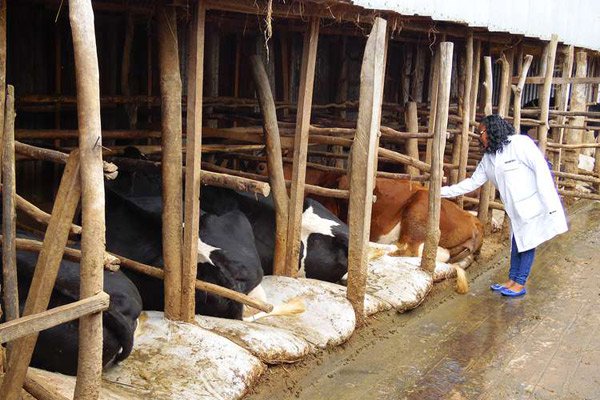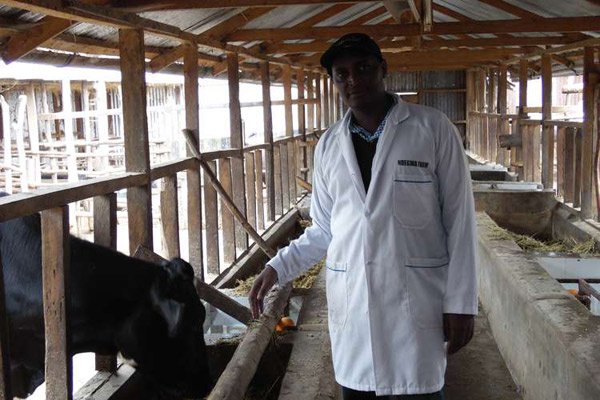Kenneth Gitonga has been practicing dairy farming in Meru for quite sometime now. He shared with the writer of this feature, CAROLINE WAMBUI:
Gitonga is the owner of Ndegwa Farm, which is situated in Mpukone village in Kathangari, Meru County.
The farmer keeps six calves, 10 heifers, seven dry, and 12 lactating cows. The animals are chewing the cud when we arrive, the cold weather having not dampened their spirit.
Gitonga says he gets an average of 320 litres of milk a day from the 12 animals, with the lowest offering 25 litres and the highest being 40. This has made his dairy farming in Meru one of the most profitable.
And he attributes this production to his deliberate efforts to make his cows comfortable.
“I always ensure my animals are stress-free and the environment they live in offers them comfort. Poorly designed stalls can lead to injuries, abrasions and diseases such as mastitis,” he says.
To succeed in dairy farming in Meru, Gitonga offers the animals total mixed ration depending on each’s production, which they feed on throughout the day with dairy meal supplement provided at 5am, 1:30pm and 8:30pm for the lactating cows.
The shed is cleaned thrice a day and kept dry to keep diseases at bay and enable the animals rest.

“A clean shed minimises bacteria growth, offers the animals a comfortable place to lie and promotes optimal udder growth.” Cynthia Mwende, an animal science graduate from Egerton University and a consultant with SNV who was at the farm to witness the success of Gitonga’s dairy farming in Meru, says for optimum production, farmers should focus on the Cow Signals Diamond, a concept that involves proper feeding, offering of plenty of clean water, light, air, rest and space.
According to the concept, every extra hour resting equals a litre of milk per animal per day.
“It pays to invest in good bedding material and to handle cows with care and let them stay in a good environment. For maximum production, cows should rest for 14 hours a day,” says Mwende, who started working with Gitonga last October when the animals were offering an average of 150 litres a day.
A GOOD COW-SHED
She attributes increased production to implementation of the concept.
More resting, according to her, increases rumination as there is increased blood circulation to mammary system. On average, cows should chew cud between 55-70 times per session, which is a sign of good health.
“The amount of time a cow spends lying is influenced by many factors among them facilities, management and the physiological status such as pregnancy.
Depriving a cow adequate resting time may result in physiological and behavioural stress leading to altered feeding pattern and reduced milk yield.”
A good cowshed, according to her, should not have a slippery floor neither should the floor have holes nor contain some objects that may hurt the animal’s hooves.
“The floor should be well-drained as a watery environment will soften the hooves making them vulnerable to injuries that cause distress,” says Mwende, adding that a farmer should spend at least 30 minutes every day in a shed watching his animals to understand signals that show they are uncomfortable.
This way, you get to know better your cows and notice any change in behaviour and make timely management decisions. Cows communicate in signs, which are easily noticed when observing them routinely.
Philip Oketch, a consultant in Meru with Policy and Markets and an expert in dairy farming in Meru, says the cowshed should be well-ventilated to allow free flow of air to curb respiratory problems and transmission of other diseases.
“Lack of proper ventilation can lead to high moisture levels as manure gases, pathogens and dust concentrations create an adverse environment for the cows. Humid air full of gases from the dung affects the airways and lungs making the cows very vulnerable to pneumonia, especially when temperatures drop at night,” Oketch explains.
GOOD VENTILATION
A constant supply of fresh air from a well-ventilated shed is key to remove heat and humidity from animals’ environment and keep them healthy and productive.
Cows constantly produce heat and moisture mostly as part of fermentation and they continuously have to lose heat through respiration by evaporating moisture in their airwaves.
“The skin plays a role in the cooling process and when they have a problem losing body heat, heat stress sets in reducing feed intake, milk production and fertility,” says Oketch.
Gitonga, who invested Sh500,000 into the business, sells his milk to Meru Dairy Union through Abogeta Dairy Society at Sh35.
The farm stocks up to 150 tonnes of silage and produces biogas on a 90 cubic metres digester. His target is to produce 500 litres of milk from the same animals.
“Dairy farming pays, I have purchased five acres of land, refurbished my house and pay school fees from my cows,” says Gitonga on his success in dairy farming in Meru.
****
Simple ways to ensure the cow is comfortable
- When cows are comfortable, eat well, drink and rest, they stay healthy and longevity is also achieved with high productive lifespan.
- Cold and wet beddings cause discomfort and stress which will lead to decrease in feed intake and weakening of the immune system.
- In cases where animals are forced to lie on a hard surface, abrasions, lesions, abscesses, bruises and hock injuries will be evident.
- Comfortable clean and soft surface cushions are essential for a clean dry resting area and reducing distress to the animal.
- The sleeping area should be spacious and comfortable enough to give a cow more time to relax.
- The area should be in such a way that the cow gets in and rises without any obstruction. Inadequate forward lunge space causes injuries when a cow is rising from a resting place causing discomfort.
- Lighting in the shed should also be good as cows are sensitive to the amount of light in the shed. Cows should have at least 12 hours of good light per day to feed better and stimulate milk.
- Feeding trough should also be made in a way that the animals feed as in the natural way where the feeding trough is 10-15cm above the ground and it should not be sharp at the edge as to hurt the neck.
- The cow should eat in a more relaxed manner just as they do in an open ground. The neckling and the bar should also be smooth as if sharp and rough the cow will strain and get wounded causing discomfort.
- Objects like nails and pieces of iron wire that resemble hard stems of plant should be removed as cows can eat them causing puncture at the reticulum walls, the liver and the heart (hardware diseases).








